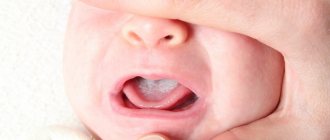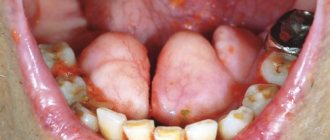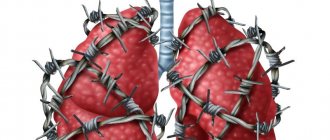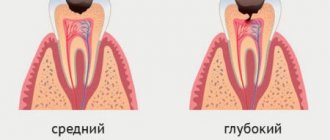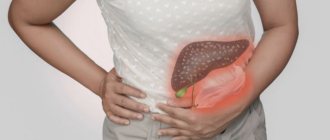Exfoliative cheilitis is an inflammation of the lips, and only the border of the lips is affected, becoming bright red, painful and irritated. To date, there is no consensus regarding the origin of the disease. Most researchers tend to believe that the cause of its occurrence is a combination of neurogenic factors. According to statistics, the majority of patients diagnosed with exfoliative cheilitis are women between twenty and forty years old.
Many patients suffering from exfoliative cheilitis have a history of psycho-emotional disorders. A significant percentage of cases are associated with depressive states, neuroses and autonomic dysfunctions. Among the provoking factors there are also immunological, endocrine and hereditary predisposition factors.
The disease has no tendency to remission or self-healing, assumes a long course and can transform over time from one form to another.
Symptoms and course of the disease
Exfoliative cheilitis has a number of characteristic signs that make it possible to diagnose it relatively accurately. The most important characteristic of this disease is its seasonality: appearing in the warm season, in spring or summer, closer to autumn it disappears for a while. The affected area is the border around the mouth that does not touch the mucous membrane. Congestive hyperemia appears on the surface of the lips, followed by the formation of keratinized scales. The lips are constantly peeling, patients complain of burning and itching. The resulting keratinized epithelial scales are easily removed and expose the red affected skin. After a week they regenerate. Due to dry lips and itching, patients acquire the habit of “biting” dead skin, which provokes further development of infection.
In the exudative form, severe pain is present in combination with swelling and hyperemia of the lip border. In addition to white or grayish scales, the affected areas are covered with painful yellow crusts from one corner of the mouth to the other. The crusts can peel off and hang down, and after their removal, the affected surface is exposed without traces of erosion, but with noticeable traces of hyperemia. The cause of this form of the disease is considered to be increased capillary permeability. During treatment, this type of exfoliative cheilitis can transform into dry cheilitis. In most cases, the disease is provoked by disturbances in the functioning of the endocrine system.
The dry form of cheilitis should be differentiated from lupus erythematosus. The key difference is the absence of pronounced atrophy of the lip border tissue in the inflamed areas.
Heilit (Zaeda)
Exfoliative cheilitis
It is a disease of the red border of the lips.
It is diagnosed mainly in women and is clinically manifested by peeling of the lips. The pathogenesis of exfoliative cheilitis includes neurological disorders - excitement, anxiety, depression. There is also a connection between the incidence of exfoliative cheilitis and hyperfunction of the thyroid gland. It has been proven that once it occurs, exfoliative cheilitis is inherited as a change in the immune system. Peeling is present only on the red border of the lips and does not spread to the mucous membrane and skin. The disease rarely spreads to the entire red border, so part of the red border in the area of the corners of the mouth and in areas bordering the skin remains free from peeling. If exfoliative cheilitis occurs against the background of dry skin, then in addition to peeling, patients note dry lips, burning, and sometimes the appearance of scales that are bitten or peeled off by hands. Exfoliative cheilitis has a long, sluggish course, with periods of remissions and exacerbations; not prone to self-healing.
During the examination, dry lips are revealed, the presence of scales tightly fused with the red border, due to which the edges of the red border look raised. Removal of the scales is usually painless; after their removal, a bright red surface without erosion is exposed. 5-7 days after removal, the scales appear again, fresh scales look like mica, and later they also adhere to the red border of the lips. With the exudative form of cheilitis, patients complain of soreness and swelling of the lips; Over time, large crusts appear, making speech and eating difficult.
Glandular cheilitis
The pathogenesis of glandular cheilitis involves congenital or acquired proliferation of the minor salivary glands, which contributes to their infection. In people with congenital anomalies of the minor salivary glands, symptoms of glandular cheilitis are observed in almost all cases. Patients with chronic periodontal diseases, tartar, and dental caries are at risk, since these diseases contribute to infection of the dilated ducts of the salivary glands.
Glandular cheilitis occurs both due to infection of the ducts of the salivary glands, and due to intoxication with toxins and waste products of microorganisms. Persons of both sexes suffer mainly after 30 years of age, while lesions of the lower lip are twice as common.
In the initial period of the disease, patients note slight dryness of the lips, which is compensated by lip care products and cracks that appear against the background of dryness. Subsequently, deep bleeding cracks and painful erosions form. Patients with grandular cheilitis tend to lick their lips, which further aggravates the symptoms of dryness, sometimes this leads to the appearance of weeping cracks against the background of dry and flaky skin of the lips. Later, the cracks are permanent due to impaired elasticity of the skin of the lips.
Contact allergic cheilitis
Occurs in response to exposure to a stimulus. The main causes of allergic cheilitis are substances that are part of lipsticks and lip care products. Allergic cheilitis can develop as a result of the bad habit of keeping foreign objects in the mouth: pens, pencils. Occupational allergic cheilitis develops in musicians in response to prolonged exposure to mouthpieces of wind instruments in the mouth.
Patients complain of severe itching, burning, swelling and redness of the lips. Moreover, after contact with an allergen, the symptoms of cheilitis are more pronounced. Sometimes the bubbles can be larger in size and after they are opened, cracks and erosions are exposed. When allergic contact cheilitis is chronic, the main clinical manifestations are peeling and slight itching without an inflammatory reaction.
Meteorological (actinic) cheilitis
It is part of a group of diseases whose pathogenesis involves hypersensitivity to cold, wind, solar radiation and radiation. Actinic cheilitis is more often diagnosed in men aged 20 to 60 years and often occurs in response to ultraviolet radiation. The survey determines general weather sensitivity, in particular sensitivity to solar radiation.
With the exudative form of cheilitis, patients complain of itching and burning of the lips, as well as the appearance of erosions and crusts. Sometimes, with meteorological cheilitis, small bubbles appear, after opening which painful erosions are exposed, which then dry out into crusts.
In the dry form of meteorological cheilitis, the main complaints are dryness and burning of the lips, and sometimes pain. In the case of a long course of actinic cheilitis, malignancy is possible; in the presence of factors such as smoking and dusty conditions in the room, the likelihood of malignancy increases. Often actinic cheilitis over time degenerates into precancerous diseases - limited hyperkeratosis, abrasive precancrosis cheilitis Manganotti, etc.
Atopic cheilitis
It is one of the manifestations of atopic dermatitis or neurodermatitis. An important pathogenetic link in atopic cheilitis is an allergic predisposition. In this case, allergens can be drugs, cosmetics, products, microorganisms and their toxins.
Patients with atopic cheilitis complain of redness of the lips, which is accompanied by itching and flaking of the red border of the lips, characteristically affecting the corners of the mouth. After the acute process subsides and during remissions, peeling and lichenification are noted. Constant dryness and infiltration of the corners of the mouth contributes to the appearance of cracks. Patients with atopic cheilitis have clinical manifestations of atopic dermatitis, neurodermatitis, dryness and flaking of the facial skin.
Macrocheilitis
Macrocheilitis is part of the Melkerson-Rossolimo-Rosenthal syndrome; the other components of the triad are facial neuritis and the folded tongue symptom. In the pathogenesis of this symptom complex, the infectious-allergic factor and hereditary predisposition are of great importance.
Patients complain of enlargement and itching of the lips, sometimes the swelling spreads to other parts of the face. Swelling with this type of cheilitis lasts indefinitely, sometimes a spontaneous improvement in well-being is possible, but after this a relapse occurs. The color of the lips and skin is not changed, although in places of swelling the skin is shiny and has a bluish-pink tint.
Usually one or both lips, cheeks, eyelids and other parts of the face in the area of innervation of the facial nerve are affected. In this case, neuritis of the facial nerve manifests itself in the form of a skewing of the face in the healthy direction, and the nasolabial fold is smoothed out. Because all three symptoms of the triad are not always present, diagnosing Melkersson–Rosenthal syndrome can be difficult.
Hypovitaminous cheilitis
It develops with a lack of B vitamins, with a particularly pronounced lack of vitamin B2. Patients complain of burning and dryness of the mucous membranes of the mouth, tongue and lips. During the examination, it is clear that the mucous membrane is slightly swollen, reddened, and on the red border of the lips there is fine scaly peeling and small vertical cracks against the background of dry and reddened skin of the lips. Cracks with hypovitaminous cheilitis are prone to bleeding and pain. Often, simultaneously with the development of cheilitis, changes are also observed in the tongue - it increases in size, and teeth marks become noticeable on it.
Diagnostics
In the process of diagnosing this disease, the key task of a specialist is to differentiate exfoliative cheilitis from other diseases that are similar in external manifestations.
Thus, the dry form of cheilitis in the diagnostic process is compared with the following diseases:
- meteorological cheilitis,
- atopic cheilitis,
- contact allergic cheilitis.
The exudative form requires differentiation with the following diseases:
- exudative form of actinic cheilitis;
- eczematous cheilitis;
- erosive-ulcerative form of lupus erythematosus.
Allergic contact cheilitis
Allergic contact cheilitis occurs as allergic contact dermatitis (see), develops as a result of sensitization of lip tissue to various chemicals. substances, for example, contained in lipstick. This cheilitis manifests itself as erythema of varying intensity, rarely - papulovesicular elements in the area of contact with the chemical, peeling of the red border of the lips, and sometimes the adjacent skin. Patients note a burning sensation on their lips.
The diagnosis of allergic contact cheilitis is established on the basis of anamnesis (contact with a chemical substance) and clinical symptoms. The diagnosis can be confirmed by skin testing with the suspected allergen. However, it should be borne in mind that there may be no parallelism in the sensitivity of the skin and the red border of the lips to sensitizing factors.
Treatment consists of eliminating the effect of the sensitizing factor and prescribing hyposensitizing agents; prednisolone ointment and emollient creams are applied topically.
The prognosis is favorable. Prevention consists of preventing re-sensitization.
Treatment of exfoliative cheilitis
Treatment of exfoliative cheilitis involves, first of all, influencing the factors that provoked it. Since cheilitis is one of the diseases associated with the patient’s psycho-emotional state, a consultation with a neurologist is often required, who can prescribe sedatives or antidepressants. If the disease occurs due to thyroid dysfunction, you will need to consult an endocrinologist.
Treatment may also include acupuncture, removal of keratinized crusts on the lips with a solution of boric acid, and in children, the use of a moisturizer.
The disease is not prone to self-healing, so it is necessary to find the cause of the disease and carry out all treatment measures in a timely manner.
Glandular cheilitis
Glandular cheilitis is characterized by the location of small salivary glands or their ducts in the outer and inner zones of the red border of the lips, their hyperplasia and hyperfunction. It can occur both primary and secondary (against the background of lip damage due to systemic lupus erythematosus, lichen planus, etc.). It usually appears in people over 30-40 years of age.
Histological examination reveals significant hypertrophy of the salivary glands, cystic expansion of their acini and ducts, and slight inflammatory infiltration.
When examined on the inner zone of the red border of the lips, and sometimes on its outer zone (usually on the lower lip), dilated mouths of the salivary glands are visible in the form of red dots, from which droplets of saliva are released in the form of dew.
The course of glandular cheilitis is torpid. When a secondary infection occurs, which is extremely rare, superficial or deep purulent glandular cheilitis develops, up to the formation of abscesses and fistulas. Occasionally, leukoplakia (see), which looks like thin rings, occurs around the dilated mouths of the salivary glands - the Puente-Acevedo form.
To identify glandular cheilitis, the patient’s lower lip should be slightly pulled back; after 20-30 seconds, droplets of saliva appear on the mucous membrane of the lip, released from the dilated mouths of the small salivary glands, which does not happen with other cheilitis.
Surgical treatment: removal or electrocoagulation of each salivary gland. Secondary glandular cheilitis disappears after resolution of the underlying disease.
The prognosis is favorable, however, irritation of the lip with saliva can contribute to the occurrence of cracks, erosions, precancerous diseases and cancer developing from the epithelium of the red border of the lip (see Lips).
Types of cheilitis
All types of cheilitis are divided into two groups:
- symptomatic (cheilitis, as a manifestation of the underlying disease);
- true (as an independent disease).
Types of symptomatic cheilitis and their clinical manifestations
The symptomatic group includes the following types of cheilitis:
- Eczematous - develops against the background of eczema, characterized by redness, swelling, burning and pathological changes in the skin of the lips. If left untreated, it becomes chronic.
- Macrocheilitis - this form of cheilitis is considered a component of Melkersson-Rossolimo-Rosenthal syndrome. There is severe itching and swelling of not only the lip, but also other parts of the face.
- Atopic - a predisposition to allergies to medications and food is a prerequisite for the development of inflammation. It manifests itself as peeling, redness, itching of the skin of the lips, and the formation of cracks in the corners of the mouth.
Meteorological cheilitis
Meteorological cheilitis, described by A.L. Mashkilleyson (1970), is a non-allergic inflammatory disease of the lips that occurs as a result of the action of various meteorological factors (low humidity, wind, cold, insolation, dust, etc.). It is observed mainly in men who work outdoors, and is most often localized on the lower lip.
Histological examination reveals diffuse uneven hyperplasia of the epithelium of the red border of the lips, in places with slight keratinization. The stroma is infiltrated, there is thickening and homogenization of elastic fibers. The red border of the lower lip is unevenly congestively hyperemic, somewhat infiltrated, and in places tightly packed scales are formed.
The course is chronic, independent of the time of year, there is no sensitization to sunlight. In contrast to systemic lupus erythematosus (a form without clinically pronounced atrophy), meteorological cheilitis does not have a sharp border of erythema and keratinization at the periphery of the lesions, which has the appearance of a palisade, and treatment with synthetic antimalarial drugs does not produce results (for lupus erythematosus, these drugs have a positive effect).
The main thing in treatment is the elimination of external adverse influences. In addition, vitamins (B2, B6, B12), local photoprotective creams (see Photoprotective agents), and prednisolone ointment are prescribed.
Meteorological cheilitis is an optional precancer with a slight potential malignancy, but against its background obligate forms of precancer (warty precancer, limited hyperkeratosis, etc.) may arise, which significantly worsens the prognosis. Prevention consists of protecting lips from damaging meteorol. factors.
Atopic cheilitis
Atopic cheilitis is one of the symptoms of atopic dermatitis (see Neurodermatitis), often at certain stages of the disease it is its only manifestation. This lesion of the lips was previously mistakenly called eczematous, microbial, seborrheic cheilitis, eczematid, etc.
With atopic cheilitis, the red border and certainly the skin of the lips are affected, and most intensely in the area of the corners of the mouth. The part of the red border that passes directly into the mucous membrane of the lips remains unaffected; the process never spreads to the mucous membrane of the mouth. Damage to the lips begins with itching and the appearance of erythema, which has fairly clear boundaries; sometimes there is slight swelling of the skin and the red border of the lips, then licheialization of the lips occurs. The red border is infiltrated and peeling is noted. its entire surface is as if cut through by thin radial grooves and resembles a harmonic. In summer, the rashes usually disappear, but the skin in the area of the corners of the mouth remains infiltrated. which contributes to the formation of small cracks.
Atopic cheilitis is similar to foliative, actinic and allergic contact cheilitis, lupus erythematosus of the lips, with which it must be differentiated. Lupus erythematosus of the lips, in contrast to atopic cheilitis, is characterized by hyperkeratosis, snow-white glow of scales in the rays of a Wood's lamp, cicatricial atrophy, and absence of itching. In some cases, differential diagnosis of atopic cheilitis with symmetrical streptococcal and candidal infections is difficult. But with seizures, the process is localized only in the corners of the mouth and, as a rule, there is no lichenification (see Candidiasis, Pyoderma).
Treatment is aimed at eliminating the underlying disease (see Neurodermatitis). Corticosteroid ointments, pastes and ointments that have antipruritic and anti-inflammatory properties are used locally; in persistent cases, Bucca rays are used (see X-ray therapy). The prognosis is usually favorable.
Angular cheilitis
We saw cracks in the corners of the interlocutor’s mouth - he has angular cheilitis due to iron deficiency anemia, riboflavin hypovitaminosis, increased levels of fungi of the genus Candida, Streptococci, Staphylococci, or simple mechanical trauma. With a decrease in the height of the lower part of the face, the folding of soft tissues in the corners of the mouth becomes the cause of the accumulation of microflora, and the actual inflammatory and destructive processes. Therefore, treatment of angular cheilitis sometimes consists of correcting the occlusal height; for streptococcal infection, in combination with ointments containing antibiotics; for candidiasis, with nystatin ointment.
